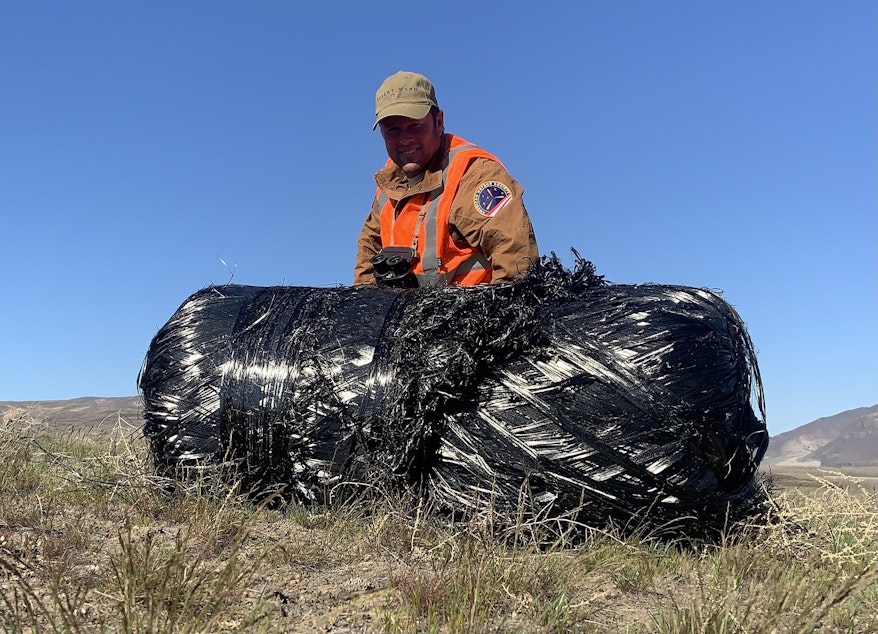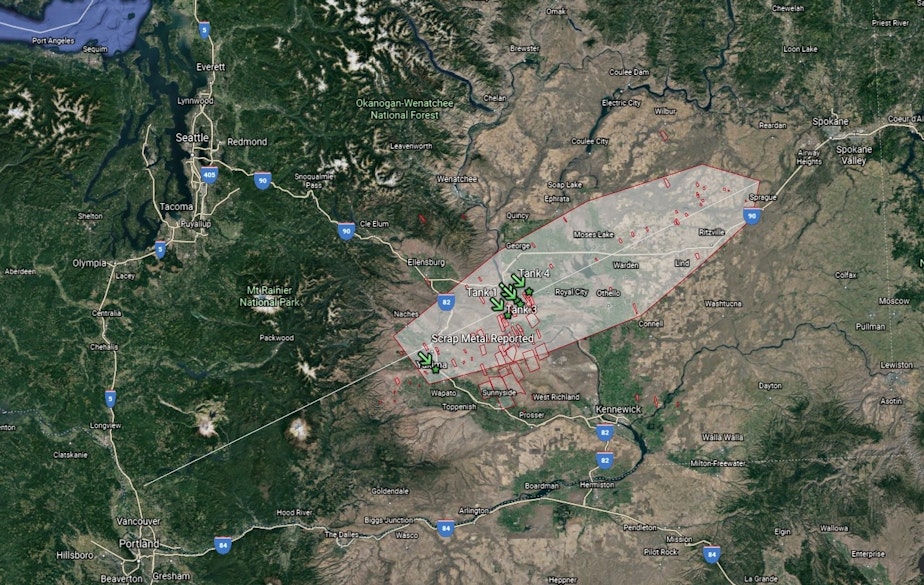Space junk sleuths hunting for rocket fireball debris in NW
Stargazers across the Pacific Northwest were treated to quite a light show in late March when the errant reentry of a spent rocket sent fireballs streaking high overhead. The uncontrolled disintegration of the rocket rained debris onto eastern Washington. While the search for mangled rocket parts goes on, the event also provided a great learning opportunity for researchers that could foreshadow a space junk warning system.
A used Chinese rocket predicted to fall out of orbit this weekend could provide a repeat show in lower latitudes -- and again raises concerns about potential debris crashing down over land. The U.S. Space Command said it is aware of and tracking the uncontrolled reentry of the ten-story tall Long March 5B rocket stage, but that "its exact entry point into the Earth’s atmosphere cannot be pinpointed until within hours of its reentry."
Hunting for fallen rockets
Social media users from northern Oregon to British Columbia captured the amazing moments during the night of March 25 when the skies lit up without warning.
The flaming debris was the upper stage of a SpaceX Falcon 9 rocket that had been used to launch commercial satellites. It wasn't supposed to reenter and break apart over populated land, but it did due to a malfunction SpaceX has not publicly explained. This has now produced a silver lining: an R&D jackpot for a trio of space junk sleuths.
"I was extraordinarily pleased by the results of the expedition," said Robert Ward, who does the on-the-ground scouting for the trio.
Ward is a skilled meteorite hunter from Arizona. He spent a combined three weeks in search of rocket pieces during two separate trips scouring the backroads and byways between Yakima and Reardan, Washington, this past month.

"We were very fortunate that the debris fell in that area of central Washington," Ward said in an interview. "The rolling hills, vineyards and orchards made for very good hunting. If it would have fallen in the forested areas, our ability to recover pieces would have been greatly hindered."
The SpaceX rocket engine and nozzle are still missing, but Ward found two propellant tanks, and he contacted landowners who found the two others. Ward passed along the exact coordinates to his virtual collaborators, Mike Hankey and Ken Howard. Hankey is a software programmer and the operations manager for the American Meteor Society. Howard is a research meteorologist with expertise in weather radar at the National Oceanic and Atmospheric Administration. Those two reconstructed the debris fall.
The trio's goal is to use this event and others like it to train computers to automatically detect falling space junk and meteors. Such a system could draw on data from live weather radars, online cameras pointed at the sky and maybe even satellites.

"This case is going to be in essence foundational to helping us develop a workflow," Howard said from the NOAA National Severe Storms Laboratory in Oklahoma.
"One of the lessons learned from this particular case is that you can have 1,000 pounds of space debris falling through commercial airspace and there is no alert or no identification that is occurring," Howard said. "And that's no fault of any one government agency, let alone my government agency. It's kind of a service gap."
This is a gap that Howard and Hankey are talking about how to plug, including whether alerts can be delivered fast enough to be useful to pilots or people on the ground. Hankey said timely confirmation that a meteorite or space junk fell out of the sky could have value even if early warning is out of reach, as seems likely for now.
"There is value in letting EMS operators know — fire departments, police — that 'Hey, this happened.' So, they don't waste resources on it looking into it," Hankey said in an interview from his home near Baltimore. "Oftentimes these are reported as a plane crashing, especially in water areas. So, that can waste a lot of resources."
Hankey predicted the fireballs over the Pacific Northwest in late March won't be an isolated event given how much space junk is overhead — with more being added at an increasing rate each year.
"It's definitely going to happen more. There's no question about that," Hankey said, noting the imminent reentry of the Chinese rocket.
A secondary area of interest to Howard in particular was the trail of small particles left behind by the streaking, disintegrating SpaceX rocket. It was thick enough to be visible on radar and stretched hundreds of kilometers in the upper atmosphere. The particle contrail could be seen on radar descending to the ground in the following 90 minutes.
"You're scratching your head, what that could be that is falling through the atmosphere," Howard said, before theorizing that it might have been carbon fiber remnants that burned off of pressure tank wrap.
"That's kind of an interest of mine, what is the radar seeing," Howard continued. "What kind of material is it? How long is it going to stay aloft? And then, does it potentially pose a hazard, which we don't know."
The other SpaceX rocket pieces?
Hankey and Ward said they would appreciate it if farmers, ranchers and orchard managers in central and eastern Washington keep an eye out for smaller rocket pieces that probably survived reentry but have not been recovered. They said there definitely could be some heavy chunks of metal from the engine, valves or even scrap metal from the rocket body around.
The objects could be half-buried in the ground from the force of impact. One of the fuel tanks that crashed into a couple's yard near the Columbia River in Grant County left a sizable dent after it was carted away.
Ward said he tried to impress upon locals he encountered to report the precise location of metal chunks that have "an aerospace look" and that show burn damage. He said that if farmers don't hit the space junk now while spraying, tilling or planting, they may find or run over it during the fall harvest.
Space debris finds can be reported through the websites of the American Meteor Society or at Ward's slick personal meteorite hunter website. Unfortunately, you can't keep any pieces you may discover. Hankey said SpaceX has asked to get all of its rocket remains back.
SpaceX sent workers to Grant County and to Ward's home in Arizona to collect the recovered rocket tanks. The Hawthorne, California-based company did not respond to a request for elaboration about its interest in the dented, crisped debris. Others surmise that an examination by materials scientists could reveal things about survivability and potential reuse of spacecraft components — an area in which SpaceX has made a name for itself.
Copyright 2021 Northwest News Network




